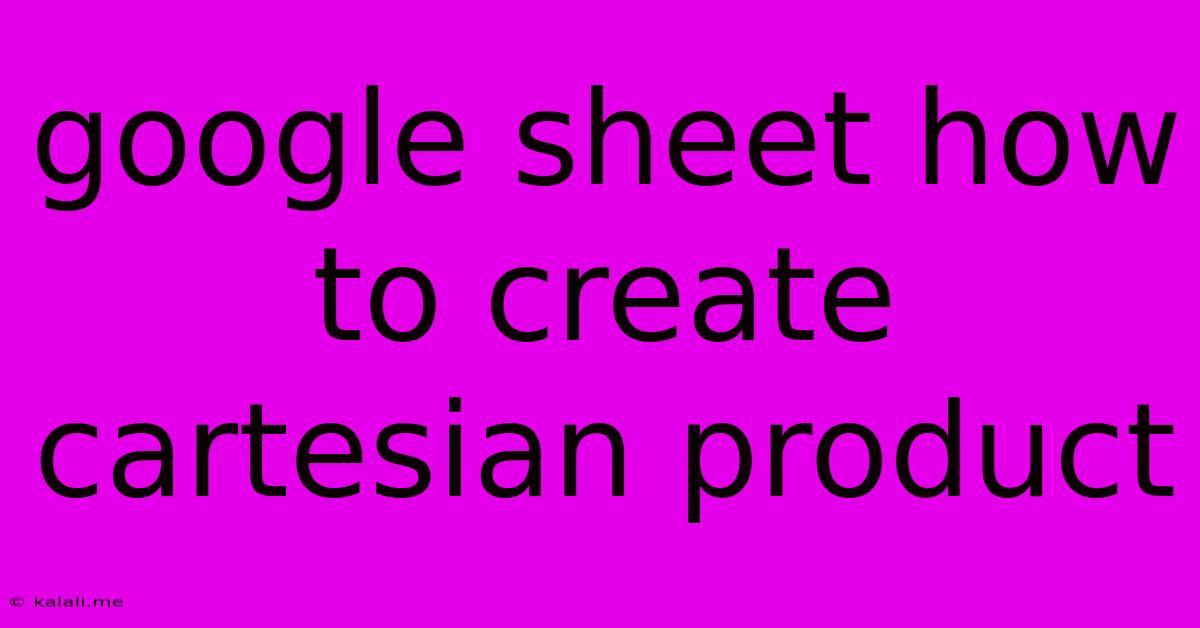Google Sheet How To Create Cartesian Product
Kalali
Jun 08, 2025 · 3 min read

Table of Contents
Generating a Cartesian Product in Google Sheets: A Comprehensive Guide
Creating a Cartesian product, also known as a cross product, in Google Sheets might seem daunting, but with the right approach, it's surprisingly straightforward. This guide will walk you through several methods, from simple formulas to more advanced techniques, enabling you to efficiently generate the Cartesian product of your data sets. This is particularly useful for tasks like generating all possible combinations, testing various scenarios, or preparing data for further analysis.
What is a Cartesian Product?
Before diving into the methods, let's define what a Cartesian product is. Given two sets, A and B, the Cartesian product (A x B) is the set of all possible ordered pairs where the first element comes from A and the second element comes from B. For example, if A = {1, 2} and B = {a, b}, then A x B = {(1, a), (1, b), (2, a), (2, b)}. This concept extends to more than two sets.
Methods for Creating a Cartesian Product in Google Sheets
We'll explore several approaches, each with its strengths and weaknesses. The best method depends on your data size and comfort level with Google Sheets formulas.
1. Using ARRAYFORMULA, ROW, COLUMN, and INDIRECT (For Smaller Datasets):
This method is effective for smaller datasets. It leverages the power of ARRAYFORMULA to generate all combinations. Let's say your Set A is in column A (A1:A2) and Set B is in column B (B1:B2). In cell C1, enter this formula:
=ARRAYFORMULA(
{
ROW(INDIRECT("1:"&COUNTA(A:A))),
COLUMN(INDIRECT("1:"&COUNTA(B:B)))
}
)
This formula combines rows and columns to generate all possible combinations. This approach scales well only to smaller data. For larger datasets it can be slow and might consume a lot of memory.
2. Concatenation with Nested IF Statements (For Small to Medium Datasets):
For slightly larger datasets, a nested IF approach, combined with concatenation, can be implemented. This method is clearer for smaller number of sets but rapidly becomes unwieldy with larger ones.
Let's assume Set A is in A1:A3 and Set B is in B1:B2. In cell C1, you could start with a formula like this (and expand it for additional sets):
=IF(ROW(C1)<=COUNTA(A:A)*COUNTA(B:B),A1&B1,"")
Then, you will need to manually expand the formula to cover all combinations by making use of nested IF statements to cycle through the various entries. The resulting formula will be complex but should work for datasets with moderate sizes.
3. Using Google Apps Script (For Large Datasets):
For large datasets, a custom Google Apps Script function is the most efficient and scalable solution. This allows you to programmatically generate the Cartesian product without straining Google Sheets' formula capabilities.
Here's a sample script:
function cartesianProduct(sets) {
function cartesianProductHelper(a, b) {
var result = [];
for (var i = 0; i < a.length; i++) {
for (var j = 0; j < b.length; j++) {
result.push(a[i].concat(b[j]));
}
}
return result;
}
if (sets.length === 0) return [[]];
if (sets.length === 1) return sets[0].map(x => [x]);
var result = sets[0];
for (var i = 1; i < sets.length; i++) {
result = cartesianProductHelper(result, sets[i]);
}
return result;
}
You can then use this function in a Google Sheet cell like this: =cartesianProduct({A1:A3, B1:B2}) (replace A1:A3 and B1:B2 with your actual data ranges). This script handles multiple sets efficiently, making it suitable for larger-scale Cartesian product generation.
Choosing the Right Method
The optimal method depends on your specific needs:
- Small datasets (<10 elements per set): The
ARRAYFORMULAmethod is usually sufficient and easy to understand. - Medium datasets (10-100 elements per set): The nested
IFapproach might be manageable, but it quickly becomes cumbersome. - Large datasets (>100 elements per set): A custom Google Apps Script function is recommended for efficiency and scalability.
By understanding these methods, you can effectively generate Cartesian products in Google Sheets, regardless of your data size and technical proficiency. Remember to adapt the range references in the formulas and scripts to match your actual data.
Latest Posts
Latest Posts
-
Who Is The Elect Lady In 2 John
Jun 08, 2025
-
How Long Does Calk Take To Dry
Jun 08, 2025
-
You Can T Win For Losing
Jun 08, 2025
-
Can You Substitute Sea Salt For Kosher Salt
Jun 08, 2025
-
How To Remove Algae From Pool
Jun 08, 2025
Related Post
Thank you for visiting our website which covers about Google Sheet How To Create Cartesian Product . We hope the information provided has been useful to you. Feel free to contact us if you have any questions or need further assistance. See you next time and don't miss to bookmark.